Unveil the allure of your garden with the perfect companion plants for hydrangeas. Renowned for their versatility, hydrangeas seamlessly blend into diverse landscapes, amplifying the beauty of both indoor and outdoor spaces with their vibrant foliage and companion plant compatibility.
More than just their aesthetic appeal, hydrangeas serve a functional role in your garden ecosystem. They offer year-round greenery, imparting structure and sophistication to your landscape. Furthermore, when thoughtfully paired with other plants, hydrangeas double as a natural pest barrier, protecting sensitive crops like tomatoes, lettuce, and beans, and attracting beneficial insects for a healthier garden environment.
Whether you’re designing a vibrant flower bed, a productive vegetable garden, or an eye-catching landscape, hydrangeas and their wide array of companion plants provide both visual splendor and practical benefits.
Embrace the charm of hydrangeas and transform your outdoor space into a tranquil sanctuary. From ornamental grasses to climbing plants like jasmine or clematis, the versatility of hydrangeas suits various landscape themes, creating captivating textural contrasts.
In this comprehensive guide, we will delve into 24 excellent companion plants for hydrangeas and highlight 7 to avoid, explaining why they are beneficial or detrimental to your hydrangeas.
Table of Contents
Good Companion plants for Hydrangeas
Flowers
1. Agapanthus
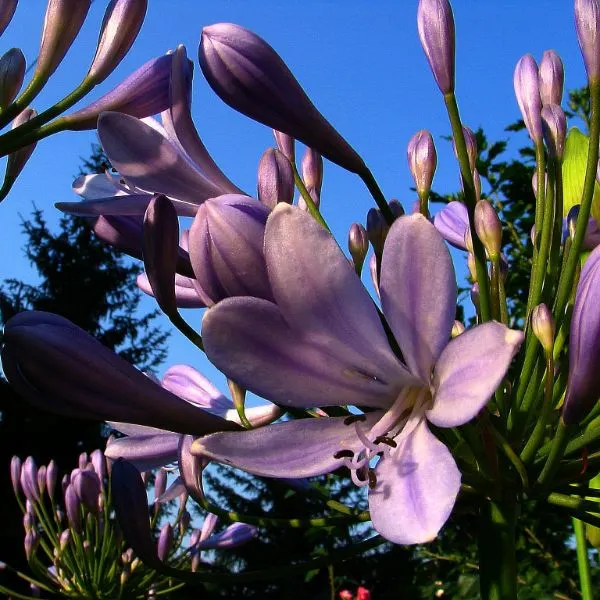
- Sun Requirements: Full sun to partial shade, at least 4-6 hours of direct sunlight
- Soil Type: Well-drained, fertile soil
Planting Hydrangeas beside Agapanthus produces a beautiful garden tapestry with brilliant colors and enticing textures. Hydrangeas’ bright blossoms provide a stunning backdrop, while Agapanthus’ elegant stature gives an impression of elegance and sophistication. They produce a harmonic alliance that delights the senses and enlivens any scene.
These companions have functional benefits in addition to their aesthetic appeal. The dense foliage of Hydrangeas offers shade, protecting Agapanthus from intense sun beams and providing a cooler environment. In exchange, Agapanthus stands tall, providing structural support to the Hydrangeas and protecting them from strong winds.
To enhance performance, maintain appropriate moisture levels for both plants by using well-drained soil, regular watering, and mulching. Your garden will flourish with an appealing color, texture, and botanical harmony display if you embrace Hydrangeas and Agapanthus’s intriguing combination. Prepare to be fascinated by this remarkable collaboration!
2. Astilbes

- Sun Requirements: Partial shade to full shade, prefers filtered sunlight
- Soil Type: Moist, rich, and well-drained soil
The mesmerizing dance of Astilbes and Hydrangeas in the yard is breathtaking. Consider a tapestry of vivid colors and exquisite textures woven together with absolute beauty and grace. Astilbes, with their feathery plumes in gentle pastels to vivid jewel tones, make a stunning contrast to the lush, plentiful flowers of Hydrangeas.
These two floral powerhouses complement each other well, with Astilbes adding an ethereal touch to Hydrangeas’ powerful beauty. Astilbes’ delicate, lacy foliage provides a magnificent backdrop for the vivid Hydrangea flowers to take center stage.
But it’s not just about looks. Astilbes’ fibrous root systems help retain moisture in the soil, benefitting both plants’ general health and vitality. Hydrangeas, on the other hand, provide shade and protection, shielding the fragile Astilbe blossoms from strong sun beams.
3. Azaleas

- Sun Requirements: Partial shade to filtered sunlight, avoid the direct afternoon sun
- Soil Type: Acidic, well-drained soil with organic matter
When it comes to the dynamic pair of Hydrangeas and Azaleas in the garden, their relationship is a symphony of beauty and mutual advantages. These floral powerhouses weave a vivid and harmonious tapestry that will captivate any observer.
Planting Hydrangeas beside Azaleas creates an eye-catching display of contrasting colors and textures. The Hydrangeas’ large, enormous blooms dance effortlessly with the Azaleas’ delicate and complex blossoms, producing an awe-inspiring visual feast.
But the enchantment does not end there. The Azaleas benefit from Hydrangeas’ desire for moisture since their common affinity for damp soil creates a balanced hydration balance. Furthermore, the Hydrangeas’ tall size provides a protective canopy, hiding the Azaleas from the sun’s beams and providing a cool, shaded sanctuary.
Allow enough room for the growth of both plants for maximum results. To meet their common demand for moisture, ensure well-draining soil that is rich in organic matter. Regular watering and trimming will maintain this energetic combo in excellent shape.
4. Bee Balm
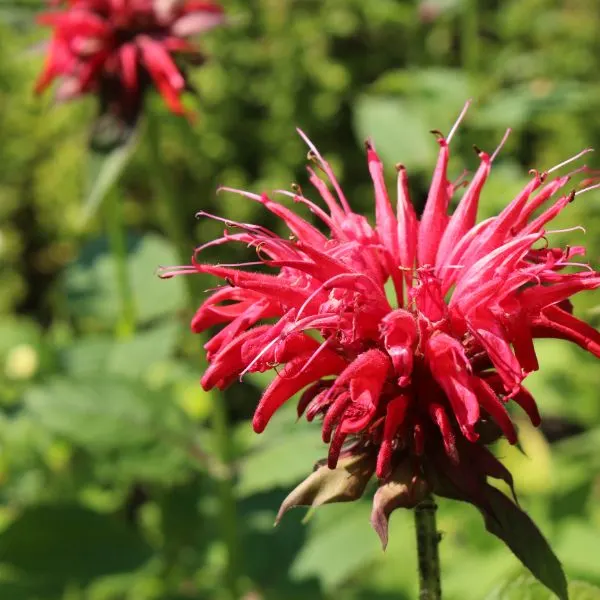
- Sun Requirements: Full sun to partial shade, at least 4-6 hours of direct sunlight
- Soil Type: Moist, well-drained soil
Planting Hydrangeas beside Bee Balm results in an enthralling combination of brilliant beauty and ecological brilliance. This powerful combination attracts bees, butterflies, and hummingbirds, increasing the biodiversity of your garden.
The vibrant clusters of Hydrangeas match the nectar-rich flowers of Bee Balm, creating a visual feast. The foliage of the Hydrangeas offers shade and protection, while the Bee Balm serves as a natural ground cover, inhibiting weeds.
Provide enough sunshine, water, and well-drained soil for success. Hydrangeas should be pruned for ventilation, and this harmonic connection should be nurtured with care. Accept the synergy, and your garden will bloom with a kaleidoscope of hues, perfumes, and buzzing life. Allow nature’s wonders to blossom before your eyes.
5. Blackeyed Susans
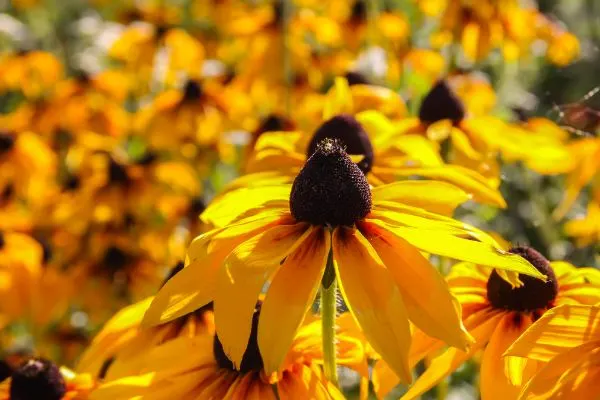
- Sun Requirements: Full sun to partial shade, at least 6 hours of direct sunlight
- Soil Type: Well-drained, average soil
Planting Hydrangeas with Blackeyed Susans produces a beautiful symphony. These botanical allies attract pollinators, bringing bright vitality to your landscape. The timeless beauty of Hydrangeas merges with the lively exuberance of Blackeyed Susans to create a vibrant tapestry that delights the senses. Their combined beauty enchants both the sight and the soul.
There are several advantages. This pair attracts bees, butterflies, and songbirds, resulting in a vibrant environment. The huge blooms of Hydrangeas and the golden petals of Blackeyed Susans merge to create a work of art of color and texture.
For maximum development, choose a sunny location with well-drained soil. Watering on a regular basis and fertilizing on occasion ensures health and vitality. Hydrangeas should be pruned in the spring to enhance flowering and prevent overcrowding.
6. Bleeding Hearts
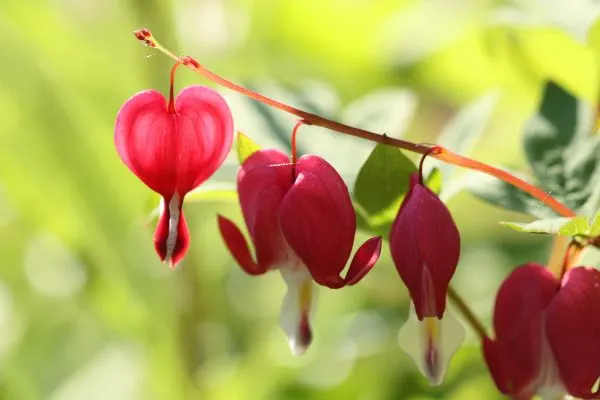
- Sun Requirements: Partial shade to full shade, prefers morning sun and afternoon shade
- Soil Type: Moist, humus-rich, well-drained soil
Planting Hydrangeas alongside Bleeding Hearts produces a beautiful floral synergy that adds enchantment and refinement to your landscape. The dramatic splendor of Hydrangeas blends with the delicate appeal of Bleeding Hearts to create a visual pleasure tapestry.
The advantages of this intriguing mix are numerous. The massive blooms of Hydrangeas contrast well with the elegant arching branches and heart-shaped petals of Bleeding Hearts, producing a magnificent contrast of form and color. Bees and butterflies are attracted to this botanical combination, which improves the pollination of neighboring plants and fosters a vibrant ecology.
One consideration is the size difference between Hydrangeas and Bleeding Hearts. Maintain adequate spacing to allow each plant to thrive and show off its distinct characteristics. Provide well-drained soil, plenty of sunshine, and frequent watering to maximize growth and vigor.
Place Hydrangeas as a backdrop, letting the Bleeding Hearts shine in the foreground to create a harmonious presentation. These plants’ diverse heights and textures give depth and visual appeal to your landscape.
Immerse yourself in the enchantment of Hydrangeas and Bleeding Hearts, where elegance meets charm and beauty abounds. Allow this botanical collaboration to enchant your senses and create a natural magnificence retreat in your outdoor sanctuary.
7. Butterfly Bushes

- Sun Requirements: Full sun, at least 6 hours of direct sunlight
- Soil Type: Well-drained, fertile soil
Planting Hydrangeas with butterfly bushes creates a captivating symphony of colors and textures that energizes your landscape. Hydrangea blooms, with their intriguing blue or pink hues, beautifully compliment the colorful petals of butterfly bushes, creating a kaleidoscope of visual enjoyment.
The advantages of this dynamic coupling are numerous. Butterfly bushes’ nectar-rich blossoms attract butterflies, hummingbirds, and other pollinators, while Hydrangeas’ luxuriant blooms make a stunning backdrop. They produce an enchanted sanctuary supporting and sustaining local fauna while promoting biodiversity and ecological balance.
Both Hydrangeas and butterfly bushes benefit from well-drained soil that is rich in organic materials. Morning sun and afternoon shadow are great for these plants because they provide the appropriate combination of light and warmth. Adequate watering and appropriate trimming are required to keep their vitality and form.
Potential winter damage, fungal diseases such as Cercospora leaf spot and powdery mildew, and pests like aphids and leaf tiers are also factors to consider. Applying proper fungicides and selecting disease-resistant varieties, for example, guarantees a vibrant and robust garden.
8. Camellias

- Sun Requirements: Partial shade to filtered sunlight, morning sun, and afternoon shade
- Soil Type: Acidic, well-drained soil with organic matter
Planting Hydrangeas with Camellias is a horticultural symphony that creates a symphony of colors, textures, and smells. These floral friends dance in sync, producing a mesmerizing show that tantalizes the senses.
The advantages of this dynamic coupling are numerous. Hydrangeas have intriguing flowers that are impacted by soil pH and come in a magnificent spectrum of blue and pink colors. Coupled with camellias’ year-round blossoming, your landscape transforms into an everchanging floral spectacle.
Camellias’ shade-loving nature and desire for well-draining soil match Hydrangeas’ requirements well, ensuring their cohabitation flourishes. Camellias lengthen the flowering season and add refinement to the environment by blooming during milder seasons.
Hydrangeas and camellias benefit from good soil, some shade, and frequent watering to thrive. Consider the compatibility of companion plants, such as azaleas, which have pink and red blossoms, lamb’s ear, which has delicate greens; and daylilies, which have a distinctive color scheme.
9. Coneflowers
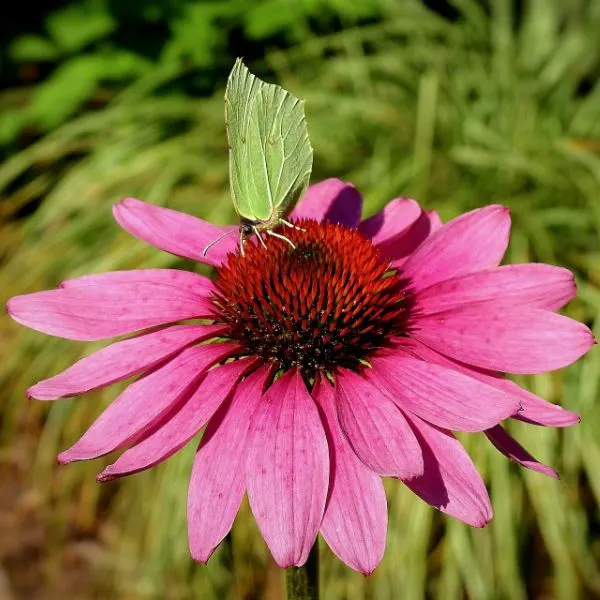
- Sun Requirements: Full sun to partial shade, at least 6 hours of direct sunlight
- Soil Type: Well-drained, average soil
Planting Hydrangeas beside Coneflowers creates a floral beauty that delights the sight and energizes the soul. These floral partners work together to create a symphony of color, texture, and ecological advantages.
The advantages of this dynamic coupling are numerous. Coneflowers’ brilliant colors and architectural structure complement the massive blooms of Hydrangeas, creating a stunning interplay of shapes and tones.
They attract a variety of important insect pollinators when grown together, increasing the richness of your garden environment. Coneflowers create vertical appeal, while Hydrangeas provide a lush backdrop, heightening the aesthetic effect.
Consider each plant’s soil type, light needs, and pruning procedures to guarantee maximum success. Combining them with complementary plants such as hostas, daylilies, and aromatic gardenias enhances the garden’s charm even more.
Accept the enchantment of Hydrangeas and Coneflowers, whose combined brilliance transforms your landscape into a natural wonderland. Allow their brilliant petals and architectural grandeur to inspire moments of amazement and admiration within nature’s blossoming tapestry.
10. Daylilies

- Sun Requirements: Full sun to partial shade, at least 6 hours of direct sunlight
- Soil Type: Well-drained soil tolerates a wide range of soil types
The combination of Hydrangeas and Daylilies produces a display of colors and textures that captivate the senses in a mesmerizing dance of horticultural harmony. These floral marvels form an unbreakable link with their tough and adaptive character, blooming in a variety of situations.
The combination of brilliant daylilies in flaming reds, pinks, and ruffled elegance with the ethereal beauty of Hydrangeas creates a stunning visual symphony. Choosing daylilies from reputed nurseries with a good eye for hues that resonate provides an elegant tapestry.
Daylily rust, for example, may be avoided by sourcing carefully. As flaming red daylilies entwined with creamy white panicle Hydrangeas, a bright red and gold daylily finds harmony beside lush, smooth Hydrangeas. The cold charm of blue lace-cap bigleaf Hydrangeas tempers the vigor of daylilies, creating a stunning duet.
11. Foxgloves
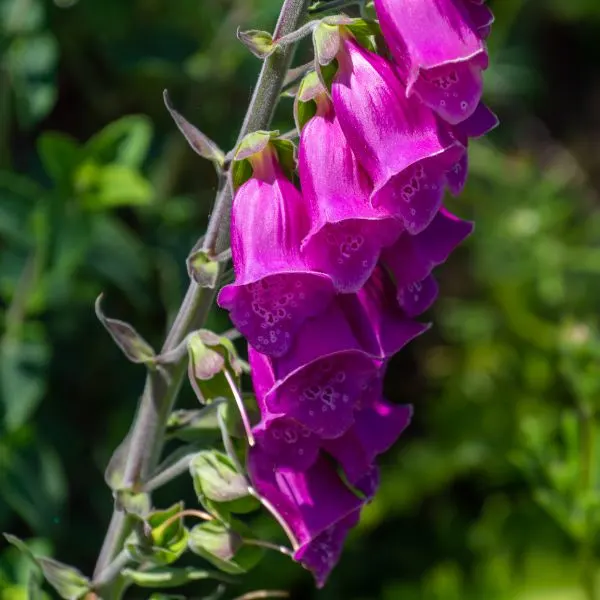
- Sun Requirements: Partial shade to filtered sunlight, morning sun, and afternoon shade
- Soil Type: Moist, well-drained soil
The marriage of Hydrangeas and Foxgloves sparks a symphony of hues and textures in the enchanted realm of floral combinations, where nature’s brilliance unfolds with compelling charm. Foxgloves of several kinds, such as Digitalis parviflora, D. ferruginea, as well as D. lanata, in a harmonized display, beautifully accompanies the native UK foxglove, Digitalis purpurea.
These resilient foxgloves from Spain and Turkey thrive in somewhat gloomy situations, coexisting nicely with Hydrangeas to make a captivating tapestry. A ballet of chocolate tones arises when mixing small-flowered foxgloves with bronze fennel, while strawberry foxgloves create a delicate pink foil to Iris ‘Dutch Chocolate.’ In wooded settings, ferns and campanulas join the symphony, while fluffy textures and flower spikes mingle with Euphorbias and snowy woodrush.
Challenges are faced with caution, with rich, well-draining soil and frequent hydration provided for these botanical companions. Capturing the seeds of foxgloves when they blossom assures that their delightful presence will continue. Allow the vitality of Hydrangeas and Foxgloves to fill your landscape, where their marriage creates a brilliant masterpiece in harmonizing tones, establishing a universe that is both authoritative and approachable.
12. Hellebores
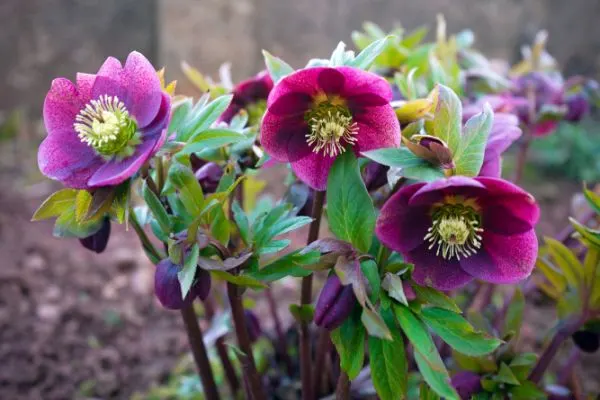
- Sun Requirements: Partial shade to full shade, prefers filtered sunlight
- Soil Type: Rich, well-drained soil
The charming marriage of Hydrangeas and Hellebores brings in a floral tapestry that dances with lively vitality and eternal attraction. These two floral miracles interweave when the second week of April reveals its brilliance, producing a display of year-round color and aesthetic enjoyment.
Hydrangeas lend drama to any garden with their enormous, beautiful flower clusters, while hellebores mesmerize with their flowers. These hardy flowers flourish in a variety of lighting situations and soil types, embracing gardens of all kinds. The hypnotic palette of hydrangea blossoms, which is regulated by soil pH, spans from enthralling blues to delicate pinks.
As the seasons change, these botanical partners attract pollinators, adding to your garden’s thriving environment. Enjoy the beauty of this powerful combo, and let the beautiful symphony of Hydrangeas and Hellebores captivate your senses, eternally an authoritative yet approachable monument to nature’s majesty.
13. Lady’s Mantle
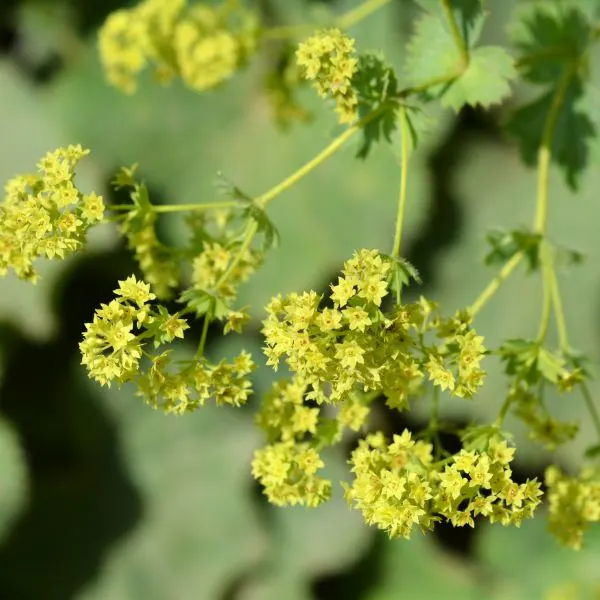
- Sun Requirements: Full sun to partial shade, at least 4-6 hours of direct sunlight
- Soil Type: Moist, well-drained soil
Enjoy the mesmerizing dance of Hydrangeas and Lady’s Mantle as they mingle in a floral symphony. Lady’s Mantle finds peace in the company of vivid friends, each bringing distinct advantages and exquisite beauty.
With their contrasting hues and stunning backdrops, these chosen partners increase the attraction of Lady’s Mantle, from the royal heights of Alliums to the copious flowers of Peonies, Salvia, and Roses. Alliums enhance verticality and fill empty areas while requiring little maintenance. Peonies in full bloom offer a striking contrast with the lush foliage of Lady’s Mantle. Salvia, with its tall and vivid blooms, not only catches the eye but also overcomes the height gap by growing in similar conditions. Finally, Roses’ ageless beauty and aroma blend perfectly, creating a stunning complement for Lady’s Mantle.
By combining these magnificent plants, your garden will be transformed into a harmonious refuge of nature’s craftsmanship. Consider sunshine, soil drainage, and watering requirements to maintain their harmonious cohabitation. They construct a tapestry of botanical grandeur in which each plant flourishes and your landscape blooms with dazzling vitality.
14. Lungwort

- Sun Requirements: Partial shade to full shade, prefers filtered sunlight
- Soil Type: Moist, well-drained soil
Unleash the enthralling synergy of Hydrangeas and Lungwort as they combine in a floral embrace, delivering a plethora of benefits to each other. Hydrangeas provide a magnificent backdrop for the fragile Lungwort, improving both visual appeal and ecological balance.
The beautiful Lungwort, with its gorgeous silver, spotted leaves and clusters of vivid blooms, seeks refuge in the company of its dynamic friend. Hydrangeas cast dappled shade, protecting the Lungwort from direct sunshine, and their tall size gives texture and depth to the garden scene.
The union of these two botanical marvels offers distinct advantages. The ground-covering nature of Lungwort serves to reduce weeds, whilst the thicker foliage of hydrangeas gives shade and protection. They work together to generate a microclimate that promotes development and life.
Consider the ideal growth conditions for each plant, including soil moisture, light needs, and pH levels, to achieve maximum success. Lungwort prefers part shade and damp soil, whilst Hydrangeas prefer well-drained soil and dappled sunlight. Adequate spacing and frequent irrigation will encourage good cohabitation.
15. Liriope
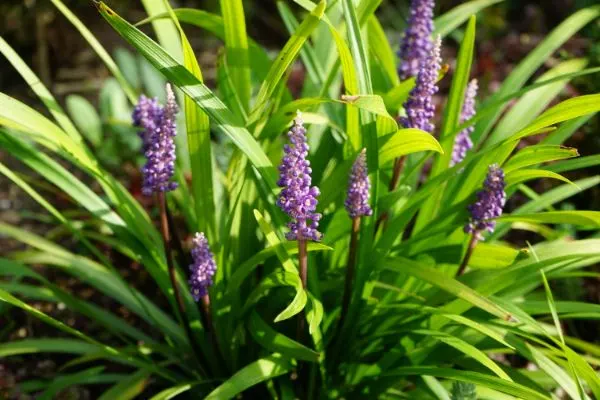
- Sun Requirements: Full sun to partial shade, at least 4-6 hours of direct sunlight
- Soil Type: Well-drained, average soil
Hydrangeas and Liriope collaborate in a vivid plant symphony that is both beautiful and functional. They create a harmonic equilibrium with their contrasting textures and hues. Hydrangeas offer height and structure, while Liriope functions as a ground cover, controlling weeds and reducing erosion.
This dynamic combination improves soil quality while also attracting beneficial insects, resulting in a vibrant ecology. Hydrangeas like wet, well-drained soil and dappled sunshine, whilst Liriope prefers part shade and well-drained soil.
The synergy is enhanced by careful spacing, watering, and the incorporation of suitable companions such as hellebores, hostas, or ferns. Explore this horticultural experience where Hydrangeas and Liriope intertwine to create a stunning wonder. Allow their collaboration to infuse your environment with vitality and awe-inspiring appeal.
16. Phlox

- Sun Requirements: Full sun to partial shade, at least 6 hours of direct sunlight
- Soil Type: Well-drained, fertile soil
The mesmerizing dance of Hydrangeas and Phlox produces a floral masterpiece that captivates the senses and the spirit. These enthralling partners intertwine in a symphony of brilliant colors, textures, and aromas, producing a sight that takes everyone’s breath away.
Hydrangeas, with their gigantic blossoms and rich foliage, provide a lovely tapestry of hues against the tiny flowers of Phlox. The pair thrives in well-drained soil and moderate sunshine but requires careful watering and spacing.
The propensity of Phlox to attract pollinators compliments the attractiveness of Hydrangeas, attracting a bustling chorus of butterflies and bees. However, there are difficulties in maintaining moisture levels because Hydrangeas require moderate watering while Phlox enjoys slightly damp soil.
Provide proper ventilation, deadhead spent flowers, and guard against powdery mildew to guarantee success. Witness the development of a floral miracle that enchants both nature and admirers by embracing the synergy of Hydrangeas and Phlox.
17. Russian Sage
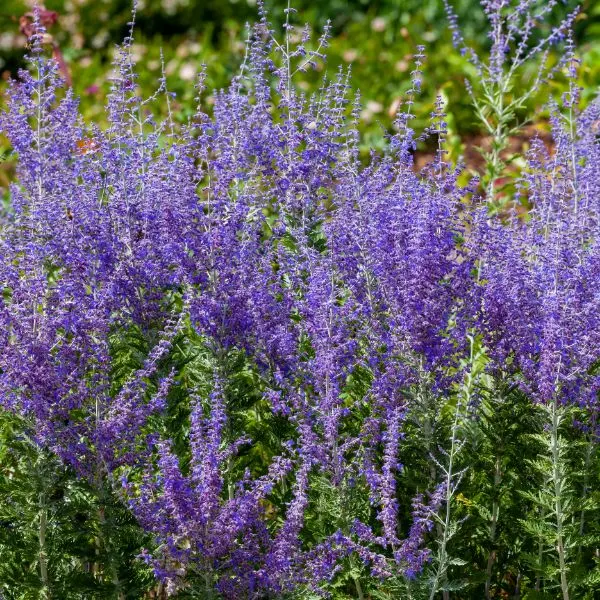
- Sun Requirements: Full sun, at least 6 hours of direct sunlight
- Soil Type: Well-drained, average soil
Witness the spectacular marriage of Hydrangeas and Russian Sage, a floral ballet of astounding grandeur. They make a duet that enchants the senses by harmonizing opposing textures, colors and smells. Hydrangeas, with their vibrant blossoms and lush foliage, make an eye-catching backdrop for Russian Sage’s ethereal, silver-gray foliage and wispy, lavender-blue flowers.
This powerful combination thrives in the hot sun and well-drained soil, commanding attention and admiration. While Hydrangeas like moderate moisture, Russian Sage prefers drier conditions, demanding careful watering.
These plants’ complementing height and architectural structure create a fascinating interaction that adds depth and complexity to any landscape. Accept their mutual love of sunshine, give them enough space, and watch the fascinating symphony of beauty bloom.
A garden filled with Hydrangeas and Russian Sage transforms into an aesthetic masterpiece, an appealing refuge that stirs the spirit and captivates all who see it.
18. Salvia
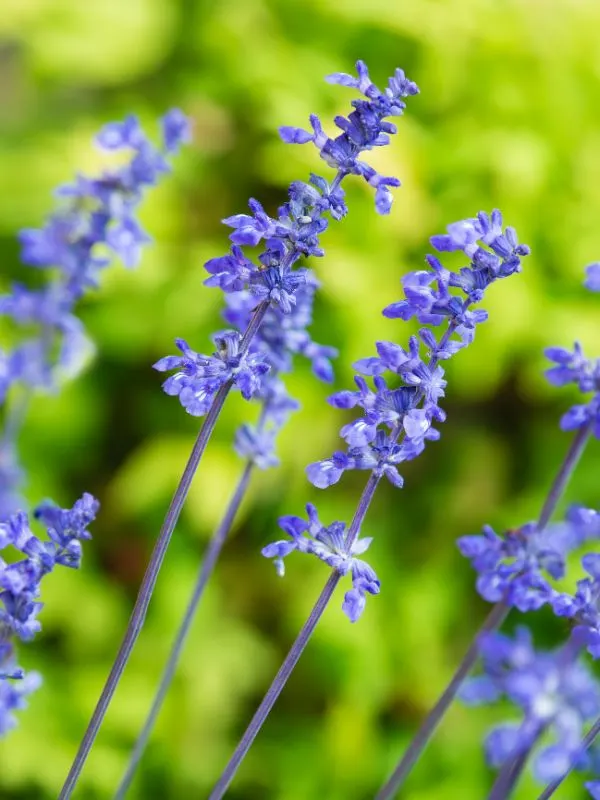
- Sun Requirements: Full sun to partial shade, at least 6 hours of direct sunlight
- Soil Type: Well-drained, average soil
Planting Hydrangeas with Salvia provides an enticing combination of rewards and difficulties, resulting in a magnificent garden tapestry. Hydrangeas add elegance and adaptability to the mix with their beautiful flower heads in a variety of hues.
These quick plants flourish in a variety of environments, from sandy coastal soils to shaded forests. Meanwhile, Salvia adds to this collaboration with its scented leaves and eye-catching blooms. The particular benefit of their coexistence is that Hydrangeas’ towering size gives partial shade that favors Salvia, while Salvia’s shorter stature assures adequate light for Hydrangeas.
However, because both plants have different water requirements, keeping regular moisture and preventing waterlogging are issues. Well-drained, organic-rich soil is essential for maximum success.
This powerful pair will thrive in your garden with careful attention to soil pH for Hydrangeas’ preferred bloom color, frequent watering, and pruning according to each species’ demands.
19. Sedum
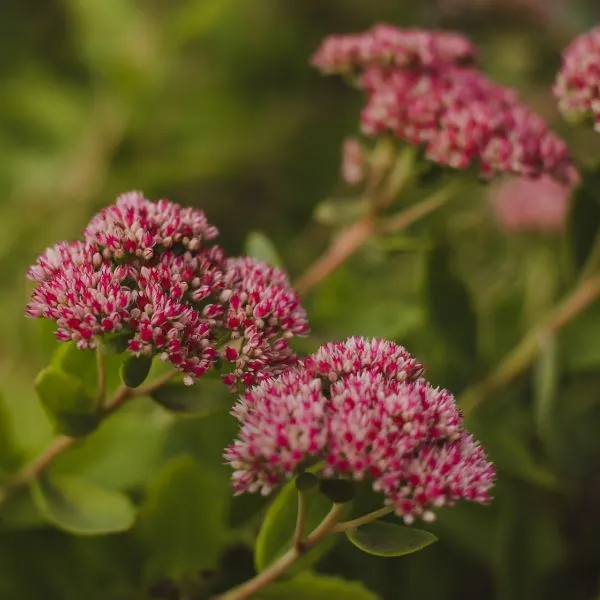
- Sun Requirements: Full sun to partial shade, at least 6 hours of direct sunlight
- Soil Type: Well-drained, average soil
Planting Hydrangeas beside Sedum creates a beautiful and functional combination. These vivid companions complement one another, resulting in a magnificent landscape show while benefiting from their own characteristics.
Hydrangeas, with their spectacular blossoms and rich foliage, make an arresting backdrop for Sedum’s succulent allure. The diverse textures and hues attract pollinators such as bees and butterflies, increasing biodiversity.
They create a hardy pair because Sedum’s drought tolerance compliments Hydrangeas’ propensity for well-drained soil. Plant them in a sunny location with well-drained soil, including grit, for increased drainage.
Pruning and division on a regular basis assist in keeping their vigor and avoid drooping. Take advantage of the dynamic interaction of these botanical allies to create a captivating garden tapestry.
20. Shasta Daisies
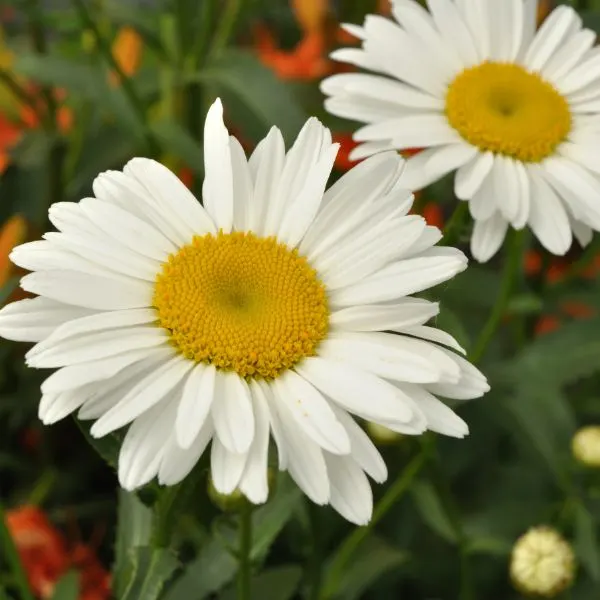
- Sun Requirements: Full sun to partial shade, at least 6 hours of direct sunlight
- Soil Type: Well-drained, fertile soil
Planting Hydrangeas alongside Shasta Daisies creates a pleasing garden show with a number of advantages. These colorful partners combine the white and yellow hues of Shasta Daisies with the beautiful pinks, blues, and reds of Hydrangeas to create a striking color interplay.
They thrive in full sun and well-draining, nutrient-rich soil and have comparable care requirements, making them perfect mates. Hydrangeas, which may grow to be 4 to 8 feet tall, match the 2 to 4-foot-tall Shasta Daisies.
A stunning visual tapestry emerges as a result of Hydrangeas’ unique benefit of soil acidity influencing bloom hues. Plant Hydrangeas behind or to the side of Shasta Daisies for the best results, enjoying a harmonic combination that enchants the senses.
21. Verbena

- Sun Requirements: Full sun, at least 6 hours of direct sunlight
- Soil Type: Well-drained, average soil
Planting Hydrangeas with Verbena creates a symphony of brilliant hues as well as useful benefits in your garden. These two floral miracles work together to enchant the eye while also nourishing the ecology. Hydrangeas give a magnificent backdrop for the delicate Verbena flowers, which provide low, wide coverage in dazzling tones with their abundant blossoms and astonishing tints. They attract beneficial pollinators while repelling common pests when grown together. Dill, cilantro, and garlic’s pungent presence function as a natural repellent to spider mites, protecting both plants. Thrips are discouraged by basil, which offers an extra layer of resistance. Provide these sun-loving buddies with a well-drained, sunny setting, avoiding excessive shade and water that may cause powdery mildew. Allow your garden to bloom, as this botanical combination creates a symphony of beauty and resilience.
Shrubs
22. Boxwoods
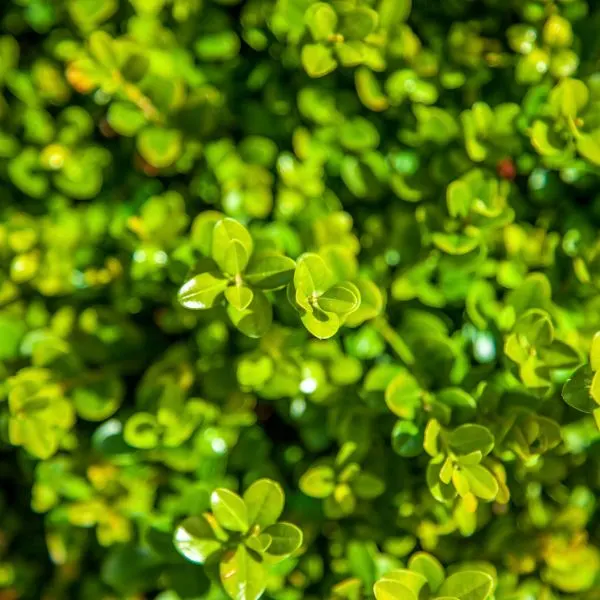
- Sun Requirements: Partial shade to full sun, prefers morning sun and afternoon shade
- Soil Type: Well-drained soil that tolerates a range of soil types
Boxwoods in front provide a bright and visually appealing mix for your yard. The vibrant blossoms of hydrangeas, which come in white, pink, purple, and blue, stand out against the evergreen boxwoods.
To preserve landscape balance, choose smaller kinds, such as smooth hydrangeas. Hydrangeas thrive in slightly shaded settings with rich, acidic soils and 1 inch of water per week.
Consider the lily of the valley as a delicate accent plant or periwinkle as a colorful ground cover in front of boxwoods. These pairings may provide complexity and structure to your landscape while elegantly complimenting the boxwoods.
23. Rhododendrons (Certain Species)
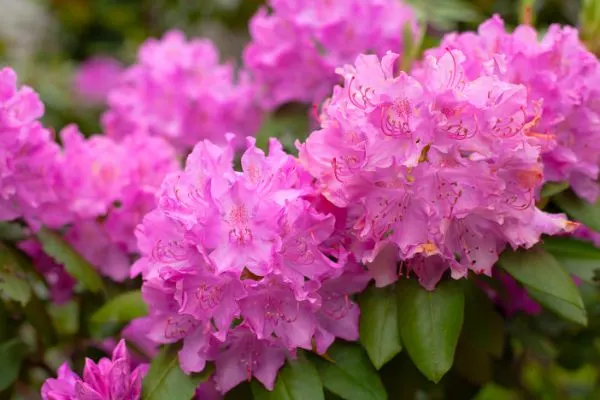
- Sun Requirements: Partial shade to filtered sunlight, morning sun, and afternoon shade
- Soil Type: Acidic, well-drained soil with organic matter
The combination of hydrangeas and rhododendrons creates a stunning symphony of beauty and elegance in any garden. Hydrangeas from Asia and America, and rhododendrons from all over the world, including the Pacific Northwest and Europe, are native to distinct places. These plants have similar propagation and soil requirements.
Both are easily reproduced by stem cuttings, which are best done in the fall or early spring. Hydrangeas tolerate somewhat higher pH levels and flourish on acidic soil with a pH range of 55.5. Hydrangea colors are affected by soil acidity, resulting in blue flowers in acidic soil and pink blossoms in alkaline soil. Rhododendrons, on the other hand, are less sensitive to soil pH and thrive in acidic soil.
These plants require well-drained soil to avoid root rot, and organic matter enrichment guarantees maximum development. While hydrangeas benefit from early spring fertilizer, rhododendrons only need it if they look to be in poor health.
Azaleas and rhododendrons work well with hydrangeas for companion planting because they both like shade, acidic soil, and organic mulch. Following these rules will allow your garden to thrive with the colorful appeal of hydrangeas and rhododendrons, which complement each other’s natural beauty.
Trees
24. Japanese maple trees
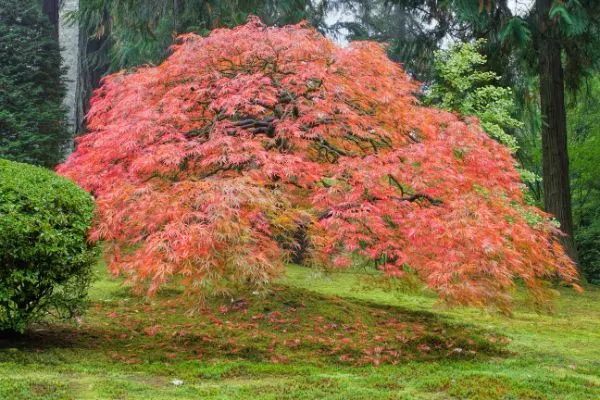
- Sun Requirements: Partial shade to filtered sunlight, morning sun, and afternoon shade
- Soil Type: Moist, well-drained soil with organic matter
Planting Hydrangeas with Japanese Maples creates a compelling mix that adds enchantment to your landscape. A visually spectacular show is created by the frenetic mix of brilliant Hydrangea blossoms and the beautiful foliage of Japanese Maples.
The contrasting hues and textures give a sensory feast, producing feelings of calm and amazement. These crops grow together because they offer each other partial shade. Plant them in well-draining soil that is rich in organic materials for the best results.
Watering and trimming on a regular basis will keep them alive. Accept this enticing combo to enhance the charm of your landscape and produce a sense of balance and elegance.
Bad Companion plants for Hydrangeas
Flowers
Lilacs (Some species)
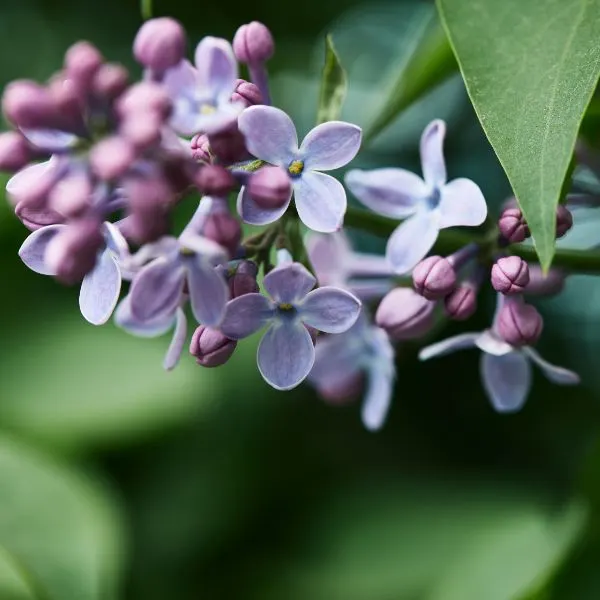
Planting Hydrangeas alongside Lilacs can be a difficult task with unanticipated outcomes.
The clash of these two floral titans results in a furious resource fight as they compete for sunshine, water, and nutrients. Their rapid development knows no limitations, reaching towering heights that dwarf other garden residents.
While their vivid hues initially catch the senses, their massive scale rapidly takes over the environment. These fierce adversaries also need careful attention to soil pH, with Hydrangeas preferring acidic circumstances and Lilacs flourishing in a slightly acidic to a neutral environment.
Balancing their divergent requirements necessitates a deft touch. Strategic planting and attentive upkeep are required for maximum results. When combining these botanical behemoths, proceed with caution since their cohabitation may spark an epic battle for domination.
Trees
Planting hydrangeas near black walnut trees, pines, firs, spruces, junipers, and cedar trees can be detrimental to both plant development and health.
While hydrangeas are largely resistant to juglone, a harmful chemical generated by black walnut trees, their presence may nevertheless create difficult circumstances.
Walnut trees’ allelopathic nature can hamper the development of surrounding plants, and their deep shadow can restrict sunlight availability, hurting hydrangea blooms.
Furthermore, coniferous plants with shallow root systems, such as pines, firs, spruces, junipers, and cedars, compete for water and nutrients, potentially slowing hydrangea development and resulting in nutritional shortages.
To address these issues, grow hydrangeas in places with plenty of sunshine and well-drained soil, away from the allelopathic impact of walnut trees and conifers. Regular watering, proper fertilizer, and annual soil testing can help such plant combinations thrive.
FAQs
What is the best landscaping with hydrangeas?

Hydrangeas flourish in wooded environments, but don’t put them too close to trees so they don’t fight for water. Plant hostas, native plants, or spring-flowering bulbs around them before the trees leaf out.
Are hydrangeas better in pots or ground?
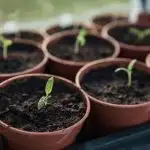
If you’ve previously researched how to grow hydrangeas, you’ll know that these plants like organically rich soil that doesn’t dry up in the summer. As a result, they are often happier planted directly into the ground, as containers dry out much faster.
Can hydrangeas grow from cuttings?
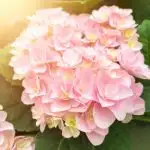
Hydrangeas are very easy to grow from cuttings. Therefore, the plants you have that are growing roots/shoots may be put in your yard quickly and effectively. There are many hydrangea kinds to pick from, so perhaps these are decent ones.
When and where is the best time to plant hydrangeas?
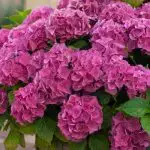
The timing will differ depending on where you live. Hydrangeas, for example, should be planted in early spring or early fall (as soon as summer heat fades) in places with winter freezing and snow. In warmer climates with mild winters, the planting season for hydrangeas extends from fall to early April.
What are the flowering times for hydrangeas?
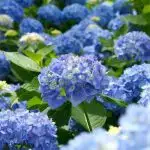
Hydrangeas, for example, blossom from mid to late summer on the previous year’s growth. Mophead and lace cap hydrangeas bloom well with minimal care, but frequent pruning fosters fresh, strong growth, which can result in a nicer show.
What do hydrangeas symbolize?

The Hydrangea symbolizes thanksgiving, grace, and beauty. It also exudes richness due to the number of blossoms and the large spherical form. Its colors represent love, harmony, and peace.
Conclusion
Hydrangeas are well known for their stunning beauty. These flowering bushes provide a wonderful touch to any garden with their magnificent diversity of colors and textures. They flourish in a wide range of soil types, from well-drained to heavy clay, as long as the soil is continually wet.
Pruning on a regular basis is essential for maintaining their perfect size and shape and supporting healthy development.
A balanced fertilizer application that is high in nitrogen, phosphate, and potassium enables effective nutrient absorption. Hydrangeas are a fantastic asset to your landscape because of their variety and attractiveness. Embrace Hydrangeas’ charm and bask in their enchanting presence.
More gardening guides
